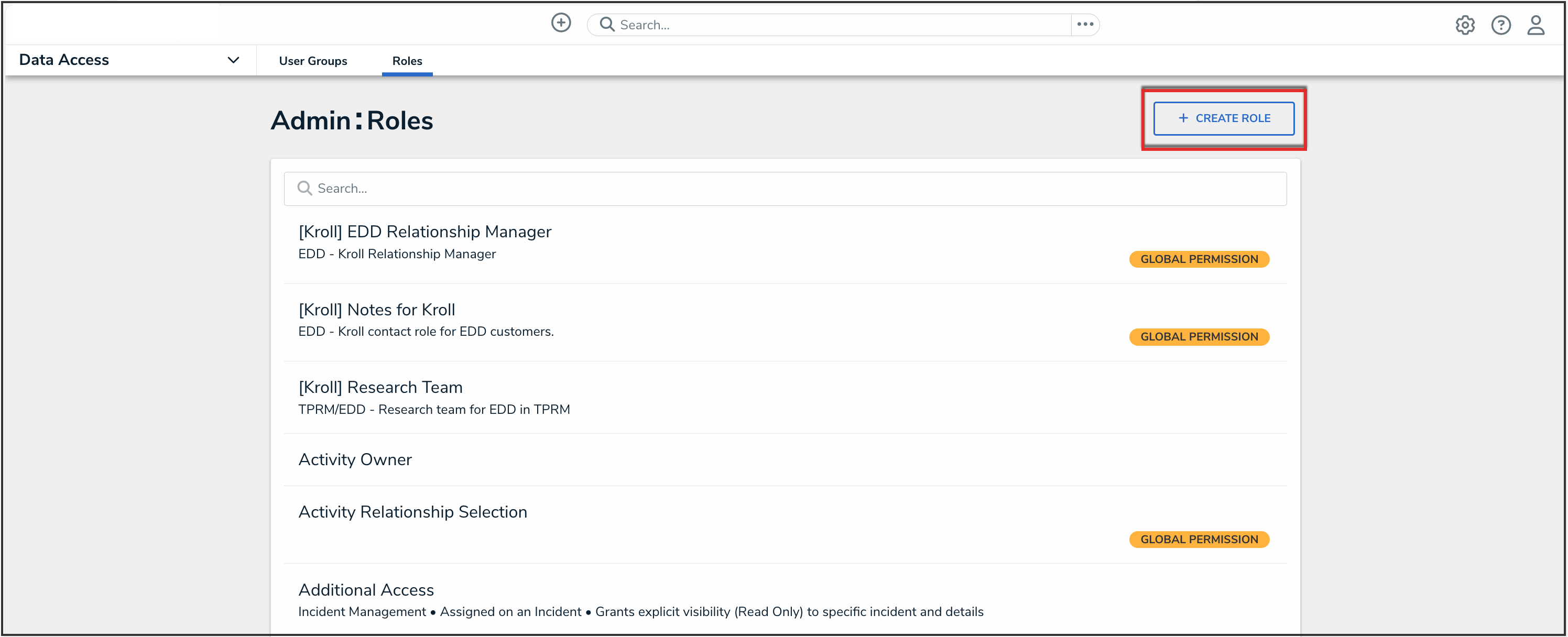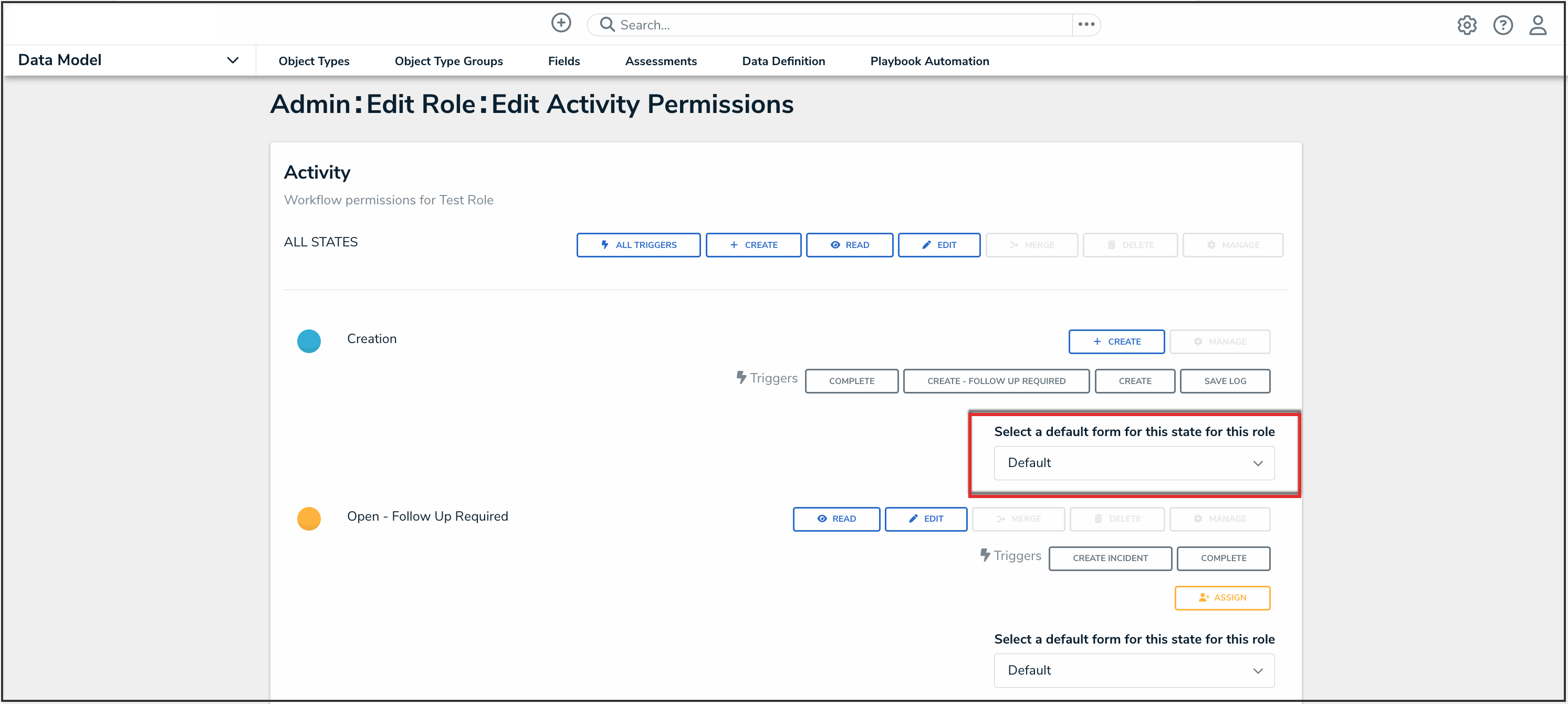Overview
Roles control the data that users can create, edit, delete, view, or manage in Resolver by adding individual users or user groups to a role, selecting the object type(s) those users can see, applying either global or explicit permissions, then configuring the workflow permissions for each object type added to the role.
 Note:
Note:
If a user is in multiple roles and the permissions are in conflict, the role with the higher level of permissions will take precedence. You can review which roles an individual user has been added to from the User Memberships section on the Edit User screen.
User Account Requirements
The user must have Administrator permissions to access the Data Access section in the Admin Overview screen.
Related Information/Setup
Please refer to the Roles Overview article for more information on using roles in Resolver.
Navigation
-
From the Home screen, click the Administration icon.

Administration Icon
- From the Administrator settings menu, click Admin Overview.

Administrator Settings Menu
- From the Admin Overview screen, click the Roles tile under the Data Access section.

Roles Tile
Creating a New Role
- From the Roles screen, click the Create Role button.

Create Role Button
- Enter the name for the role in the Name field.

Name Field
- (Optional): Enter a description of the role in the Description field. This description will appear below the role’s name when editing it.

Description Field
- (Optional): Select the Enable Global Membership checkbox if you wish to grant this role global permissions.

Enable Global Membership Checkbox
 Note:
Note:
Once a role is created, you cannot enable or disable global membership (permissions) from the Edit Roles screen. To enable or disable global permissions on an existing role, you must delete then recreate the role.
- Click the Create button.

Create Button
- In the field under Object Types, type the name of the object type you want to add, then press Enter on your keyboard or select it from the dropdown menu.

Object Types Field
- Click the Edit Permissions button to configure the workflow permissions.

Edit Permissions Button
 Note:
Note:
An object type will not be saved to a role until you’ve configured its workflow permissions. - Select the workflow permissions the user will have per each state:
- All States: Clicking All Triggers, Create, Read, and Edit in this section will automatically enable these permissions for all states in the workflow.
- All Triggers: Users can view and click all triggers on a form. The triggers that are visible to user depend on whether the object is in the state associated with the trigger. You can also select each individual trigger to grant access.
- Create: Users can create a new object. This permission applies only to the Creation state of the object type.
- Read: Users can view the object when it’s in the selected state. You cannot select the Edit, Delete, or Manage permissions unless Read has been selected.
- Edit: Users can edit existing objects in the selected state.
- Delete: Users can delete existing objects in the selected state.
- Manage: Users can add users from other roles to give them access to the object while it’s in the selected state. Note that the added user will not see the object until it’s in a state they have permission to view. Manage is applicable to explicit permissions only.
- Assign: Once the object is in the selected state, users who have been granted permission to view the object through a role will see it in their task list on the My Tasks page. Assign is applicable to explicit permissions only.

Edit Permissions Screen
- From the Select a default form for this state for this role dropdown menu, choose the form users will see when using Search, Quick Add, an assessment table, or relationship graph.

Select a Default Form For This State For This Role Dropdown
- If you do not choose a form from this dropdown menu, the object type’s default form (the unconfigured list of components added to an object type) will be displayed.
- If you select Default Form from this dropdown menu, the user will see the form selected by an administrator.
- If you select a configurable form from this dropdown menu, the selected form will be displayed.
 Note:
Note:
Forms selected to display on an action, view, data visualization, or relationship table will override any selections made in the Select a default form for this state for this role field.
- Click the Done button to save your changes.

Done Button
- Repeat steps 6-10 to continue adding object types as needed.
- To add individual users to the role:
- In the field under Users, begin typing the name of the user you want to add to the role in, then press Enter on your keyboard or click to select the user.

Users Field
- Repeat as needed to add more users, then click the Add Selected button.

Add Selected Button
- In the field under Users, begin typing the name of the user you want to add to the role in, then press Enter on your keyboard or click to select the user.
- To add a user group to the role:
- In the field under User Groups, begin typing the name of the user group you want to add to the role, then press Enter on your keyboard or click to select the user group.

User Groups Field
- Repeat as needed to add more user groups, then click the Add Selected button.

Add Selected Button
- In the field under User Groups, begin typing the name of the user group you want to add to the role, then press Enter on your keyboard or click to select the user group.
- (Optional): In the Advanced Options section, you can select which advanced options to to enable or disable for users within the role. Please refer to the Advanced Options on Roles article for more information.
- Click the Done button to save your changes.

Done Button






 Note:
Note:










